If your company has a Sustainability strategy If you want to develop a sustainability strategy, you will find out here how to design an effective sustainability strategy: Clearly analyse the status quo (motivation, responsibility, potential), define a clear core of vision, positioning and focus - and consistently dovetail objectives, governance, measures and KPIs.
As a company, it is worth developing a sustainability strategy that is truly well-founded and authentic. We therefore show you the steps you need to take to do just that. You can find the complete overview in our Comprehensive guide to sustainability strategy in the company.
Many companies have recognised how important Sustainability for them. This is why they often take individual sustainability measures. However, in order to have a truly positive impact on the environment and society on the one hand and to be authentic on the other, it takes more than individual measures. A sustainability strategy helps companies to take a focussed approach to sustainability, anchor it in the long term and communicate it even more clearly.
If your company wants to go beyond a strategy and initiate a permanent process, we describe in the Article on sustainability transformation in detail the 3 dimensions of transformation and the 4 phases.
Checklist: develop a sustainability strategy in the company in 7 steps
- Status quo analysis: Four dimensions (0-3) + short Materiality analysis carry out → Record top 3 topics and risks.
- Define core: Ambition (1 sentence), Mission (1 set) and Positioning (clear value contribution for customers & society).
- Set focus: 3-10 Fields of action prioritise (impact × feasibility); document exclusion criteria/no-goes.
- Clarify breadth & depth: Consistency (affected areas) × Ambition level (intensity) in a simple matrix.
- Determine goals & KPIs: Per focus topic SMART target, Baseline, Target year, Responsible:r and Measuring method define.
- Secure governance & resources: Roles & responsibilities, budget, incentives, Monitoring rhythm (monthly/quarterly) and define decision-making rules.
- Building a roadmap of measures: Quick Wins (60-90 days) + Milestones 12-36 months plan; Reporting bridge to DNK/ESRS/VSME manufacture.
Table of contents
- Checklist: develop a sustainability strategy in the company in 7 steps
- A) Analysis for the sustainability strategy (status quo): How to start
- Dimension 0: Determine the initial status of the sustainability strategy in the company
- Dimension 1: entrepreneurial interest - motivation and business case for sustainability
- Dimension 2: Real responsibility towards the environment and society
- Dimension 3: Existing potential - successfully integrating sustainability
- B) Develop the core of the sustainability strategy for the company
- C) Develop goals, KPIs and form of the sustainability strategy for the company
- Conclusion: Developing a sustainability strategy in a company is a feasible and highly individualised process
- Frequently asked questions about the article
A) Analysis for the sustainability strategy (status quo): How to start
The base of every strategy is a sound basis. However, this basis is perhaps even more important for the development of a sustainability strategy in companies. After all, sustainability is a particularly complex issue: success cannot be measured by annual profit alone, the demands of the Stakeholders must be taken into account and there may even be conflicting views among employees.
With the analysis for the sustainability strategy, we highlight different perspectives on sustainability. We therefore distinguish between three perspectives for a solid foundation:
- Entrepreneurial: A company's interest in sustainability
- Footprint & weaknesses: The company's responsibility towards people and nature
- Handprint & strengths: The potential for sustainability that already exists in the company
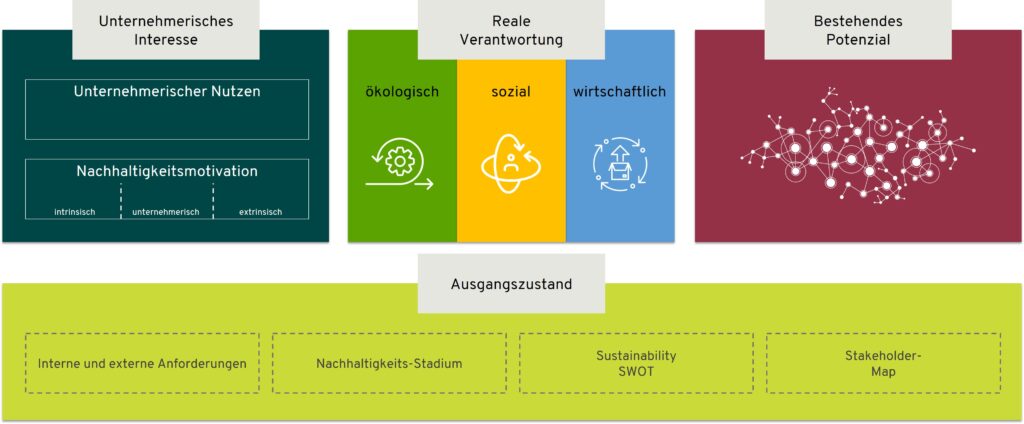
Dimension 0: Determine the initial status of the sustainability strategy in the company
It usually helps to first build up an understanding of where the company stands in terms of sustainability. This understanding helps to establish the important broader view of sustainability within the company.

Determine the sustainability stage of the company
Sometimes models help you to understand where you stand. This can help enormously in developing a sustainability strategy within the company. A simple and widely suitable model is the Sustainability Stages of the Global Compact. It shows in 5 stages how a company develops from reactive sustainability crisis management to an integrated understanding of sustainability.
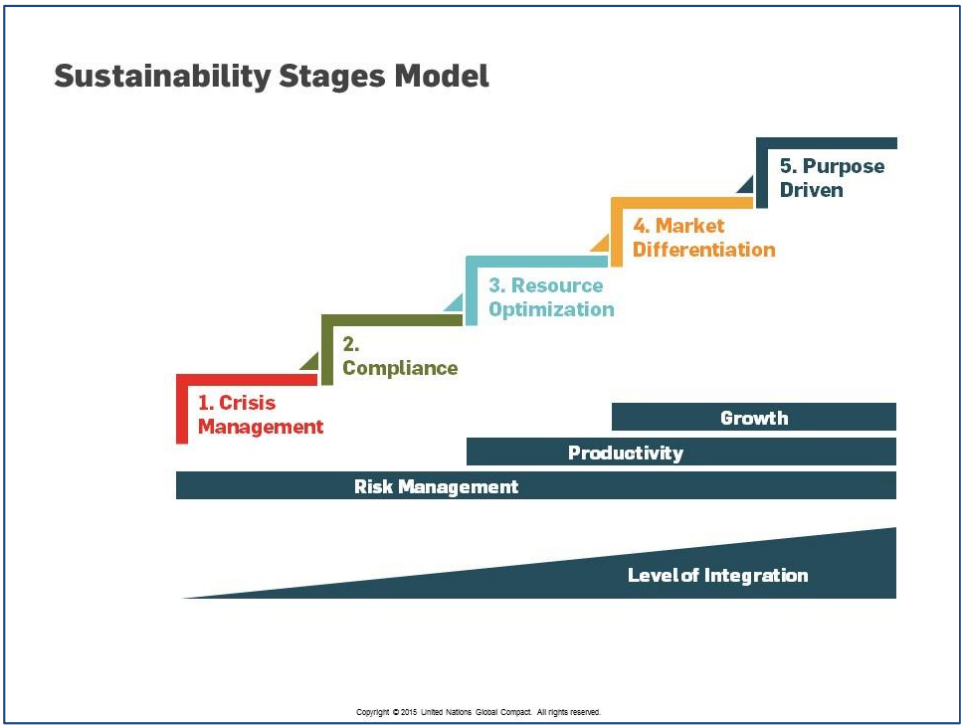
The entire concept can be found in the LEAD Programme of the Global Compact.
We recommend using such models merely as a starting point for your own discussions and analyses. Organisations are too complex to be completely squeezed into models. The result may be, for example, a list of the business areas, organisational units and sustainability topics in which you consider yourself to be advanced.
Draw up a stakeholder map
A stakeholder map helps to find out which groups have an interest in the company's activities or are even affected by them. Internal and external stakeholders are collected in this map, for example. It then helps to describe what interests they have in the company's activities. Finally, the company can evaluate them. For example, according to how much influence they have on the company and how much influence the company has on them. Here is a Detailed instructions.
Recognising internal and external sustainability requirements
- Results of employee surveys, opinions from management, feedback from recruiting and marketing
- Receivables from shareholders, parent companies, etc.
- Demands from NGOs, consumer organisations and others
- Requirements from the competition and the market in terms of sustainability
- Legal requirements such as CSRDsupply chain laws, etc.
Carry out a sustainability SWOT analysis
The results of the previous steps can be incorporated into a sustainability SWOT. This is a valuable tool for developing a sustainability strategy within the company. The classic SWOT analysis is a familiar tool for many companies. To build on what we know, we can carry out a sustainability SWOT analysis to identify strengths, weaknesses, risks and opportunities for sustainability. Here we differentiate between the risks for the company in terms of sustainability, for example, and the risks for sustainability dimensions by the company. The result is a prioritised list of topics in the company and on sustainability that should probably be included in the strategy.
Dimension 1: entrepreneurial interest - motivation and business case for sustainability
Socio-ecological sustainability can only work in the long term if it is also economically successful - this also describes the third dimension of sustainability. To achieve this, we need to work out what added business value our sustainability strategy can deliver. In addition, we must not forget that the people in the organisation, above all the management, have some kind of motivation for sustainability.

What is your own motivation for sustainability (quite honestly)?
We have found that companies' motivations for sustainability can be roughly categorised into three groups, each of which forms a different starting point for the subsequent strategy.
- Intrinsic motivation of the management
- Opportunities: authenticity, enthusiasm, quickly becoming part of the culture
- Risks: blind idealism, high costs, frustration
- Entrepreneurial motivation
- Opportunities: Effective and targeted development of sustainability, attractiveness of the topic through profitability
- Risks: Greenwashingtoo strongly anchored in communication
- Extrinsic motivation through regulations, customer requirements, etc.
- Opportunities: cost-efficient implementation
- Risks: Greenwashing (high), no ROI
Our recommendation is not to base a sustainability strategy in companies on purely extrinsic motivation. If there is primarily intrinsic motivation, it makes sense to also awaken entrepreneurial motivation in order to enable the economic success of the sustainability strategy. If there is primarily an entrepreneurial motivation, it is also worthwhile to develop an intrinsic motivation in the medium term. Building management motivation.
Identifying the business benefits of sustainability
We can look at various aspects to find out how sustainability can contribute to corporate development:
- How can sustainability issues be integrated into the existing Corporate strategy contribute?
- Which entrepreneurial problems can be addressed through sustainability activities? E.g. employer attractiveness, differentiation from competitors, innovation incentive, branding, facilitation of financing through sustainable finance criteria.
- Which entrepreneurial risks can we prevent with sustainability? E.g. climate impact adaptation, media trends such as 2019 plastic waste, 2020 climate targets, 2024 heatwave summers.
- How can a "Business Case for Sustainability" look like in the company? Find out more in our articles on Business models and Innovation.
Dimension 2: Real responsibility towards the environment and society
In addition to the economic incentive for sustainability in the company, real responsibility from a social perspective plays an even greater role. This means finding out which social and ecological resources a company uses and where there is a risk of overuse.
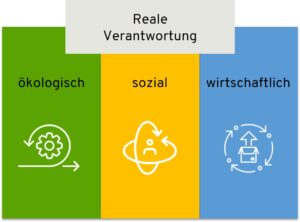
As the resources are very different, it is necessary to use separate survey procedures for each of them. These range from life cycle assessments/LCAs to human rights indices of the supplier countries and employee satisfaction with the corporate culture.
Currently, all of these analyses typically run in a Double materiality analysis(DWA) together. For most companies, they form the basis for developing a sustainability strategy. In this strategy, the topics are determined on which the organisation has the greatest influence and which, conversely, have the greatest influence on the organisation. Logically, the sustainability strategy should address precisely these topics.
Dimension 3: Existing potential - successfully integrating sustainability
Last but not least, it should be identified where there is particular potential in the company to implement possible sustainability topics and measures. Many strategies fail in their implementation because they encounter implicit or explicit resistance. The topic of sustainability in particular can be very controversial. Therefore, a step-by-step implementation that utilises points of contact and avoids blockades is more promising.
The following aspects, among others, can be analysed to identify the potential:
- Which Sustainability activities to date worked well and which worked badly? Why was this the case?
- With Which employees are motivated for the topic? Who is perhaps involved in the issues on a voluntary basis?
- Which Departments may be of particular interest on the topics? Who can benefit most from it?
- Which other programmes or goals can sustainability be helpful?
- In which existing (management) systems can sustainability issues be integrated?
- Which Conflicting goals with other goals and activities could occur?
B) Develop the core of the sustainability strategy for the company
Once the analysis has compiled all the necessary information, we use it to develop the core of the sustainability strategy.
Sustainability vision, mission, purpose (value-orientated)
Most companies are familiar with Vision and a mission sometimes alternatively to develop a purpose. We therefore also use this tool in the development of a sustainability strategy. The aim is for these statements to motivate our own employees or customers, even inspire them and provide orientation.
Depending on how you want to apply it, sustainability vision and mission can mean the following:
- Vision: "What does a sustainable world look like for you? What does your industry / topic specifically look like?"
- Mission: "How can you contribute to making this sustainable future a reality?"
The sustainability vision, mission and, if applicable, purpose thus form the core of a sustainability mission statement. In other contexts (e.g. traditional management systems), this may be summarised together with values in a sustainability policy.
A disclaimer from us: If you run the risk of the sustainability vision or one of the other two variants becoming a generic statement after a long battle of words, which makes nothing more tangible and motivates no one: Leave it alone.
Sustainability positioning (market-orientated)
Strategy is more than a long-term plan, at least according to Henry Mintzberg. In particular, a sustainability strategy should include a positioning in order to implement sustainability successfully from an economic perspective. Based on Graham Kennysustainability positioning can be summarised as follows:
- "What do I want from my most important stakeholders in terms of sustainability (and why)?"
The wording initially seems contrary to how we often understand strategy, but it gets to the heart of the matter very cleverly. Exemplary positioning can then be:
- "We want the most innovative and sustainable suppliers to want to work with us so that we can always initiate the best innovations."
- "We want to be valued by our safety-conscious customers for our stable sustainability products, not for constant innovation."
We believe that sustainability must be increasingly positioned as a conscious market positioning. Otherwise, it will remain an expensive on-top issue instead of being successful in the long term.

Do you want to get out of your comfort zone and into the transformation?
Ask me for a free information meeting.
I am ready with advice and pleasure.
Toni Koç
Sustainability strategy and reporting topics
Set the focus: Choosing the right topics for the sustainability strategy
For many companies, sustainability is like an overflowing bouquet of flowers and they don't know which flowers to choose and why. Strategy means focus and therefore this step is essential. This is an essential step in developing an effective and successful sustainability strategy within the company.
Choosing the right topics for the strategy can look different in every organisation and unfortunately we cannot provide a blueprint for the process here. Overall, however, it is important to understand sustainability for your own company and your own business model. For manufacturing companies, sustainability issues are very different than they are for IT companies. For the former, water consumption and labour safety in the supply chain may play a role, whereas for the latter, the electricity consumption of servers and living wages for service providers are important.
Where do the topics I can choose from come from?
- from the materiality analysis,
- the Sustainability SWOT,
- the existing potential and existing measures
- and, finally, motivation and, of course, positioning.
The following questions will help with the final selection of sustainability strategy topics:
- Which topics do I derive from my sustainability positioning and/or my sustainability vision?
- In terms of which issues do I have the most serious impact on the environment and society?
- Which topics can I generate the most positive impact on?
- Which topics motivate employees?
- For which ones is an economic advantage possible?
- Which topics are currently the most discussed in society?
- Which topics are becoming necessary for us in regulatory terms?
- Etc. pp.
Companies typically select between 3 and 10 topics. We call these topics fields of action for sustainability. We often structure these fields of action further into focus topics. However, these fields of action can be located at very different levels of detail and can be more concrete or more abstract. Examples of areas of action can be found in our article Sustainability strategy examples in companies.
Depending on how detailed the sustainability strategy is to be structured, the topics can be broken down into the areas within the company. Examples of areas for manufacturing companies could be the following:
- Mechanical engineering business segment
- Contract manufacturing business segment
- ...
- Production (in our own plants)
- Supply chain and purchasing
- Product development and
- Sales and marketing
- Employees and corporate culture
- Society and Corporate Citizenship
Setting the level of ambition for sustainability
When companies develop a sustainability strategy, they perhaps have to ask themselves the question „How far do we want to go?“ more than with other strategies. No company can yet describe itself as 100% sustainable because the situation and the system do not yet allow it. The ideal level of sustainability should be carefully weighed up.
If the sustainability strategy developed is not ambitious enough, the topic will not be anchored and external parties may even accuse it of greenwashing. If the sustainability targets are set too high, they are likely to fail due to questions of profitability and, if they are not met, will reduce employee motivation.
"For most companies, however, it can be said that more ambitious targets should be set rather than targets that are too weak. Only then can sustainability gain momentum."
The example of climate protection often illustrates well how different intensity or ambitions can be.
Three differently ambitious target formulations would be, for example:
- The company wants to reduce its CO2 emissions by 30%. In return, processes will probably remain unchanged and efficiency measures will be implemented.
- The company wants to become CO2-neutral. To this end, processes are certainly being rethought, the core business is being scrutinised for climate protection and many departments are being involved.
- The company wants to become CO2-positive. The entire company and business model will be scrutinised for climate protection, all employees must be part of it, incentive and control elements for climate protection will certainly be built in and communication will be able to make it a core topic.
The decision as to how intensively sustainability should be implemented is absolutely dependent on the company and all surrounding sustainability factors. In this respect, the following questions help to clarify the intensity of the sustainability strategy:
- How great is my damage to the environment and society and how quickly should we take decisive steps forward?
- What resources are available to implement which topics?
- How will employees react to a very ambitious sustainability strategy and how will they react to a less ambitious one?
- How will customers and the public react to a very ambitious sustainability strategy and how will they react to a less ambitious one?
- Is there perhaps currently social momentum to promote sustainability?
- And many more.

C) Develop goals, KPIs and form of the sustainability strategy for the company
Once the company has developed the core of the sustainability strategy, it is time to move on to the underlying levels. This is where opinions differ as to what is still part of the strategy and what is not. Nevertheless, we show the following important steps.
Develop sustainability goals
It has proved practicable to proceed in three steps:
- First draft of the targets for the upper target levels
- Structuring the sustainability goals
- Formulation of the objectives
1. first draft of the targets for the upper target levels
Firstly, we set the focus topic targets for the entire company. These should be based on how ambitious the company wants to be in the focus topic. The sustainability goals should be just as tangible and concrete as strategic corporate goals.
To ensure that the goals for the focus topics are really concrete, it often helps to determine the purpose of the goals: What impact should be achieved on the environment or society?For example, CO2 reduction, a self-determined life for workers in the supply chain or making parenthood possible for our own employees. Or What effect should be achieved for the company?For example, the identification and motivation of employees or competitiveness.
In the simplest case, the goals simply contain their purpose in addition. For example:
- Reduce our CO2 emissions by 80% by 2030 by reducing our energy consumption.
- By 2030, promote a self-determined life for workers in our supply chain by supporting suppliers to be certified to labour standard XYZ.
These two examples show the difficulty of sustainability goals. This is because there will always be different ways to achieve a goal and it is often not clear at the beginning which one is the best. If the purpose of the goal is anchored, it is easier to conduct an honest review.
This creates an initial structure of the sustainability goals, e.g. in the form of a target tree.
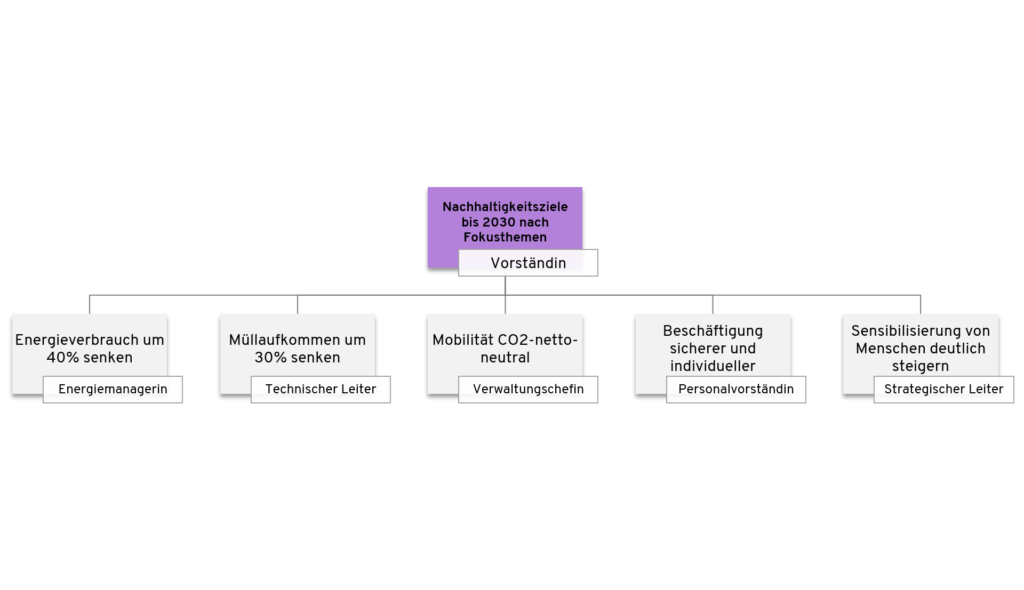
2. differentiation of the sustainability goals
In the second step, the company derives the sub-goals for the first level of the fields of action from these goals for the focus topics. These fields of action are usually orientated towards the company divisions. For example, production, purchasing and supply chain, marketing, administration, research and development, etc.
In our example, we are already going very much to the operational levelto show this as well.
Important: The following structure for the objectives should always be based on the actual structures in the company! It is counterproductive to create parallel structures.
From there, the objectives are broken down to the underlying departments and teams. Ideally, this is done by the departments themselves. They should work out which goals they need to set for the area of action or the department in order to support the goal of the respective focus topic.
The development of objectives by working groups instead of by management also ensures that employees identify more strongly with the objectives and the strategy.
Now all the objectives of the departments together result in one objective tree per focus topic.
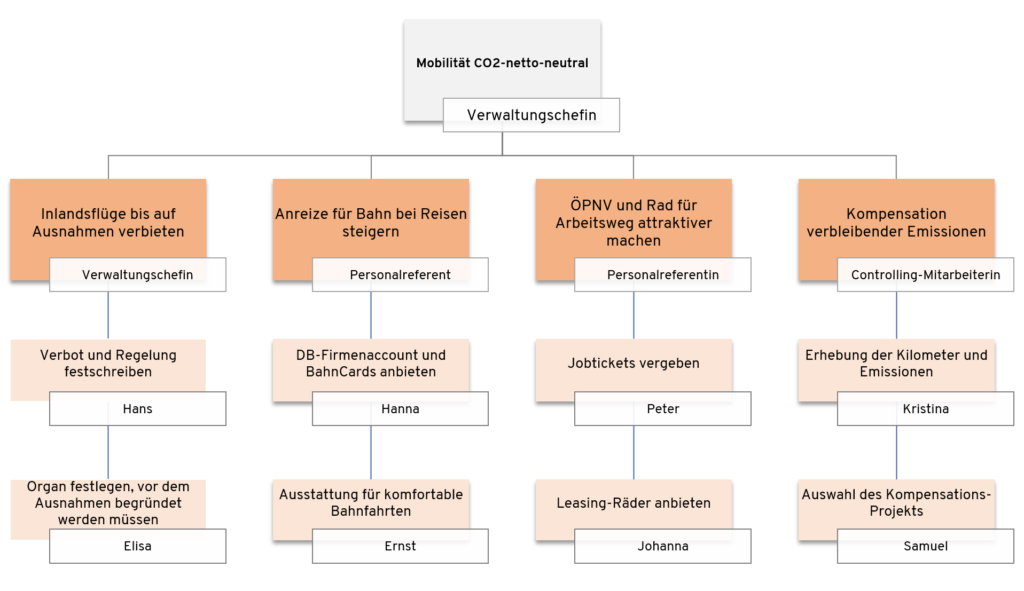
3. finalisation of the sustainability goals
The proposed objectives of the fields of action are summarised and reviewed:
- Do the objectives together achieve the overarching goal of the focus topic?
- Are there no conflicts between the objectives?
- Do the targets remain below the planned resources for realisation?
- Are all goals formulated SMART?
A revised version is then sent back to the working groups, which are then asked to check and adapt it for feasibility.
Our experience also shows that companies should plan buffers to achieve their targets. For example, the target "Climate neutral by 2030" should be planned in such a way that climate neutrality is achieved by 2028. In this way, the target can be met despite uncertainties.
The resulting final target tree serves as an important tool for all areas to achieve the sustainability targets.
For ease of use, a separate target tree can also be set up for each field of action, which maps all focus topics.
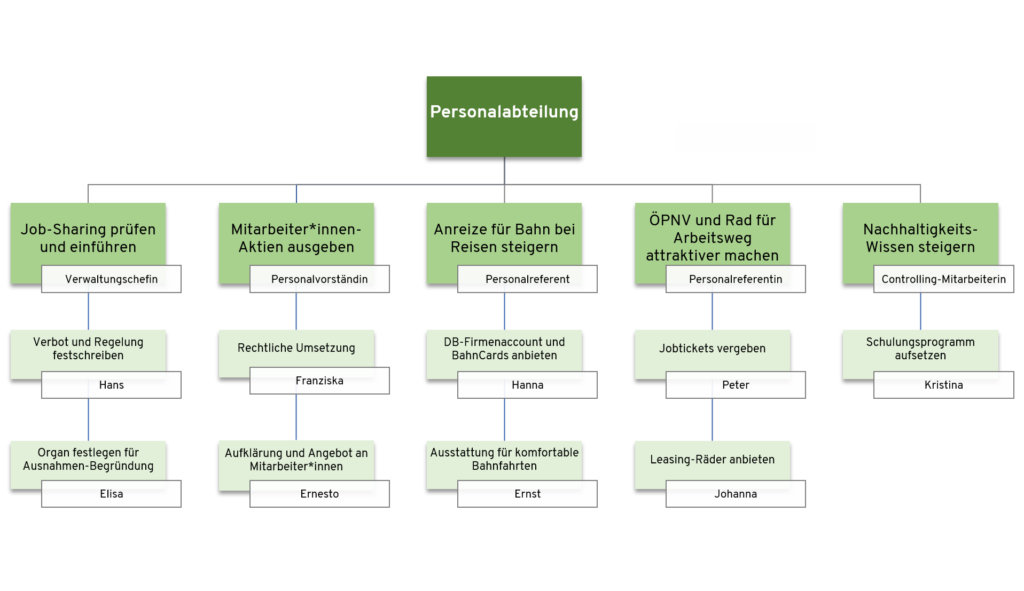
Methods and best practice for sustainability in your mailbox

Putting the company's developed sustainability strategy into the appropriate form
At the end of every strategy process, it is important to find a form that conveys the content. Such a form should help to make the developed sustainability strategy more realisable in the company, to be able to understand it later, to make it transferable or also serve as a controlling instrument.
Ideally, the form of the sustainability strategy that the company has developed fits in with other forms of strategy. Possible forms and implementations include the following:
- A classic strategy paper.
- A systematic management system that is ideally integrated into the existing system.
- For smaller companies, perhaps a more comprehensive background paper and additional pragmatic papers for the work areas.
- The Linking with suitable report formats like the GRI or the DNK to enable a coherent flow of management and reporting.
- The modern form of a Sustainability Handbookssimilar to the well-known brand handbooks. In this way, the background and implementation of the sustainability strategy can be conveyed in an understandable form.
Develop sustainability measures and KPIs
The strategy can only be implemented if measures follow. And measures are often only implemented in a targeted manner if their success can be measured.
We will not go into detail here, but refer you to our article on the Implementation of a sustainability strategyincluding the development of measures - and to the articles on Sustainability KPIs in general and concrete KPIs.
Conclusion: Developing a sustainability strategy in a company is a feasible and highly individualised process
However, there are aids, tools and comparable positive examples for each step, so that a suitable and individualised sustainable corporate development can be taken in each case.
The steps described for developing a sustainability strategy are nothing unusual for companies per se. The special features of developing a sustainability strategy are the complexity, the large number of interests to be taken into account and the need to ensure authenticity.
All of the above points provide guidance for developing a sustainability strategy. Some points are particularly helpful in successfully implementing the process:
- an intensive and comprehensive understanding of sustainability in order to be authentically effective,
- a good feel for the company, the culture and the employees in order to select topics and measures that are implemented with motivation,
- Experience with the sustainability market and public opinion in order to implement sustainability in an entrepreneurially valuable way.
The development of a well-founded sustainability strategy is the basis for making sustainability a permanent feature and for achieving long-term success in terms of sustainable corporate development. Sustainability transformation become.

Do you want to get out of your comfort zone and into the transformation?
Ask me for a free information meeting.
I am ready with advice and pleasure.
Toni Koç
Sustainability strategy and reporting topics
Frequently asked questions about the article
In short: you define a clear core of vision, positioning and focus, derive measurable goals and establish implementation, governance and KPIs. The basis is a structured status quo analysis (motivation, responsibility, potential).
Start with the Status quo analysisInitial state, entrepreneurial interest (business case), real responsibility (effects & risks) and existing potential - summarised in a double materiality analysis. Result: prioritised topics for the strategy.
1) Analysis & Materiality → 2) Vision/mission & positioning → 3) Focus/fields of action → 4) Ambition level → 5) Goals & target trees → 6) Measures & KPIs → 7) Suitable strategy form and anchoring.
This varies depending on the size/complexity and data situation. Experience: A few weeks for the analysis, then several iterations for the core, objectives and implementation design - a clear rhythm is important (e.g. fortnightly working rounds) instead of a "big bang". (Derived from process steps in the article.)
Derive fields of action from materiality, SWOT, potential and positioning and check impact × feasibility. Typical in practice are 3-10 topicswhich you can break down into focus topics and areas as required.
Today, it is the standard for prioritising topics: "impact materiality" (impact on the environment/society) × "financial materiality" (impact on the company). The strategy addresses precisely these prioritised topics.
Formulate SMART, deliberately call the Purpose (impact on the environment/society or benefit for the company) and visualise the derivation in Target treesfrom the focus topic to departments/teams.
The Strategy is the core content (objectives, measures, governance); Reporting standards are formats that make content comprehensible. Ideally, you should dovetail the two instead of viewing reporting in isolation.





[...] Develop a sustainability strategy within the company [...]
[...] the workcation can be given its own motto, e.g. "Sustainability throughout the company" or "Learning and living a culture of error". The [...] is then orientated towards this.
[...] in the article on developing a sustainability strategy, we want to go into a few aspects in more detail. Parts of this article actually belong [...]
[...] In this blog post, we have shown what role the 17 SDGs play in becoming aware of materiality. Other frameworks, such as the DNK, are also a useful aid. These provide an initial orientation and are an introduction to the consideration of sustainability in the company. The company can then build on this. To this end, it is advisable to systematically carry out a well-founded materiality analysis, including direct and indirect stakeholders. We outline a possible approach in our "Materiality analysis" guide, which then forms the basis for a holistic and effective sustainability strategy for the company. [...]
[...] or sustainability strategy, formulated and published. [Link: https://plant-values.de/eine-nachhaltigkeitsstrategie-im-unternehmen-entwickeln/6613/ [...]
[...] Overview: Developing a sustainability strategy within the company [...]
[...] Blog post: Developing and establishing a corporate strategy for sustainability [...]
[...] Overview: Developing a sustainability strategy within the company [...]
[...] What role does a clearly formulated sustainability strategy play in the assessment of companies in the context of the German Sustainability Award? Which factors [...]
[...] are particularly suitable for sensitising and activating employees and bringing sustainability strategies to life [...]